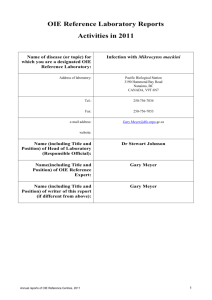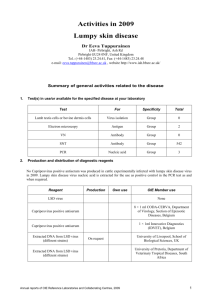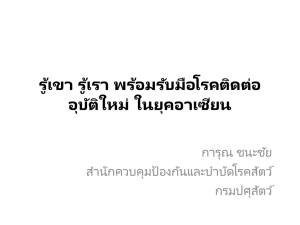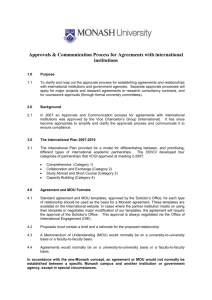Disease name
advertisement
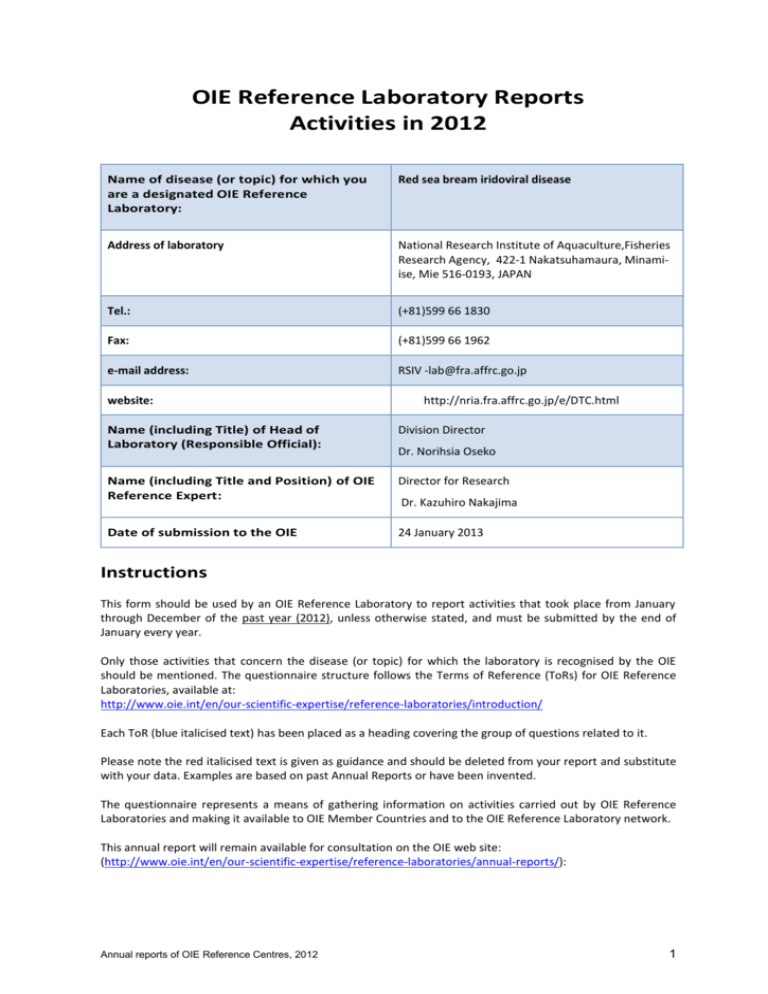
OIE Reference Laboratory Reports Activities in 2012 Name of disease (or topic) for which you are a designated OIE Reference Laboratory: Red sea bream iridoviral disease Address of laboratory National Research Institute of Aquaculture,Fisheries Research Agency, 422-1 Nakatsuhamaura, Minamiise, Mie 516-0193, JAPAN Tel.: (+81)599 66 1830 Fax: (+81)599 66 1962 e-mail address: RSIV -lab@fra.affrc.go.jp website: http://nria.fra.affrc.go.jp/e/DTC.html Name (including Title) of Head of Laboratory (Responsible Official): Division Director Name (including Title and Position) of OIE Reference Expert: Director for Research Date of submission to the OIE 24 January 2013 Dr. Norihsia Oseko Dr. Kazuhiro Nakajima Instructions This form should be used by an OIE Reference Laboratory to report activities that took place from January through December of the past year (2012), unless otherwise stated, and must be submitted by the end of January every year. Only those activities that concern the disease (or topic) for which the laboratory is recognised by the OIE should be mentioned. The questionnaire structure follows the Terms of Reference (ToRs) for OIE Reference Laboratories, available at: http://www.oie.int/en/our-scientific-expertise/reference-laboratories/introduction/ Each ToR (blue italicised text) has been placed as a heading covering the group of questions related to it. Please note the red italicised text is given as guidance and should be deleted from your report and substitute with your data. Examples are based on past Annual Reports or have been invented. The questionnaire represents a means of gathering information on activities carried out by OIE Reference Laboratories and making it available to OIE Member Countries and to the OIE Reference Laboratory network. This annual report will remain available for consultation on the OIE web site: (http://www.oie.int/en/our-scientific-expertise/reference-laboratories/annual-reports/): Annual reports of OIE Reference Centres, 2012 1 OIE RL for « Red sea bream iridoviral disease » – « Dr. Kazuhiro Nakajima » – « Japan » Total number of test performed last year Test recommended by the OIE 2. Indirect diagnostic tests Nationally Internationally IFAT 155 tests 0 tests Direct diagnostic tests Nationally Internationally Cell Culture (GF cells) 30 tests 0 tests PCR gene (1-F and 1-R primer sets) 10 tests 0 tests Did your laboratory produce or store imported standard reference reagents officially recognised by the OIE or other international bodies? Yes 3. No Did your laboratory supply standard reference reagents to OIE Member Countries? Yes 2 No Name of recipient OIE Member Countries and of institutions Type of reagent available Related diagnostic test Produced/ stored Amount supplied nationally (ml, mg) Amount supplied internationally (ml, mg) Monoclonal antibody (M10) IFAT Produced 5 ml - Shizuoka prefectural research institute of fishery Monoclonal antibody (M10) IFAT Produced 5 ml - Mie prefecture fisheries research institute Monoclonal antibody (M10) IFAT Produced 10 ml - Wakayama prefecture fisheries research institute Monoclonal antibody (M10) IFAT Produced 5 ml - Tottori prefectural fisheries experimentally station Monoclonal antibody (M10) IFAT Produced 5 ml - Oita prefectural agriculture, forestry and fisheries research center Monoclonal antibody (M10) IFAT Produced 5 ml - Tokushima agriculture, forestry and fisheries technology support center Monoclonal antibody (M10) IFAT Produced 10 ml - Kochi prefecture fisheries research institute Positive control DNA for PCR PCR Produced - l Dr. Jorge Vasquez Torres, Universidad Austral de Chile Positive control DNA for PCR PCR Produced - l Dr. Nimal Jayaweera, Central Veterinary Annual reports of OIE Reference Centres, 2012 OIE RL for « Red sea bream iridoviral disease » – « Dr. Kazuhiro Nakajima » – « Japan » Type of reagent available Related diagnostic test Produced/ stored Amount supplied nationally (ml, mg) Amount supplied internationally (ml, mg) Name of recipient OIE Member Countries and of institutions Investigation Centre, Sri Lanka Positive control DNA for PCR PCR Produced - l Universiti Putra Malaysia, Prof. Mohamed Shariff Positive control DNA for PCR PCR Produced - l Tai Lung Veterinary Laboratory, AFCD, Dr. Chow Cheuk Hung, Hong Kong SAR Positive control DNA for PCR PCR Produced l - Tottori prefectural fisheries experimentally station Positive control DNA for PCR PCR Produced l - Wakayama prefecture fisheries research institute 4. Did your laboratory produce diagnostic reagents other than the OIE-approved standard reference reagents? Yes 5. No Did your laboratory produce vaccines? No Yes 6. Did your laboratory supply vaccines to OIE Member Countries? No Yes 7. Did your laboratory develop new diagnostic methods validated according to OIE Standards for the designated pathogen or disease? Yes 8. No Did your laboratory develop new vaccines according to OIE Standards for the designated pathogen or disease? No Yes Name of the new test or diagnostic method or vaccine developed Description and References (Publication, website, etc.) qPCR Abstruct of "Annual meeting of The Japanese Society of Fish Pathology 9. Did your laboratory carry out diagnostic testing for other OIE Member Countries? Yes 10. No Did your laboratory provide expert advice in technical consultancies on the request of an OIE Member Country? Yes Annual reports of OIE Reference Laboratories, 2012 No 3 OIE RL for « Red sea bream iridoviral disease » – « Dr. Kazuhiro Nakajima » – « Japan » Name of the OIE Member Country receiving a technical consultancy Purpose How the advice was provided USDA APHIS Veterinary Services, USA Confirmation of PCR method Remote assistance 11. Did your laboratory participate in international scientific studies in collaboration with OIE Member Countries other than the own? No Yes 12. Did your Laboratory collect epizootiological data relevant to international disease control? No Yes 13. Did your laboratory disseminate epizootiological data that had been processed and analysed? No Yes 14. 15. What method of dissemination of information is most often used by your laboratory? (Indicate in the appropriate box the number by category) a) Articles published in peer-reviewed journals: ................. 1 b) International conferences: .............................................. - c) National conferences: ...................................................... 1 d) Other: ............................................................................... - Did your laboratory provide scientific and technical training to laboratory personnel from other OIE Member Countries? No Yes 16. a) Technical visits: ................................................................ b) Seminars: ......................................................................... c) Hands-on training courses: .............................................. d) Internships (>1 month): ................................................... Does your laboratory have a Quality Management System certified according to an International Standard? Yes 17. No Is your laboratory accredited by an international accreditation body? Yes No 18. Does your laboratory maintain a “biorisk management system” for the pathogen and the disease concerned? (See Manual of Diagnostic Tests and Vaccines for Terrestrial Animals 2012, Chapter 1.1.3 or Manual of Diagnostic Tests for Aquatic Animals 2012, Chapter 1.1.1) Yes 19. Did your laboratory organise scientific meetings on behalf of the OIE? Yes 4 No No Annual reports of OIE Reference Centres, 2012 OIE RL for « Red sea bream iridoviral disease » – « Dr. Kazuhiro Nakajima » – « Japan » 20. Did your laboratory participate in scientific meetings on behalf of the OIE? No Yes 21. Did your laboratory exchange information with other OIE Reference Laboratories designated for the same pathogen or disease? Yes 22. No Was your laboratory involved in maintaining a network with OIE Reference Laboratories designated for the same pathogen or disease by organising or participating in proficiency tests? Yes No Purpose of the proficiency tests: (validation of a diagnostic protocol: specify the test; quality control of vaccines: specify the vaccine type, etc.) Role of your Reference Laboratory (organiser/ participant) No. participants EU proficiency tests 2012 participant 20< 23. Participating OIE Ref. Labs/ organising OIE Ref. Lab. OIE RL for VHS, Denmark Did your laboratory collaborate with other OIE Reference Laboratories for the same disease on scientific research projects for the diagnosis or control of the pathogen of interest? Yes No Title of the project or contact Scope Name(s) of relevant OIE Reference Laboratories Assessment of virulence determinant of viral haemorrhagic septicaemia virus (VHSV) towards trout Assessment of virulence determinant of viral haemorrhagic septicaemia virus (VHSV) towards trout OIE RL for VHS, Denmark 24. Did your laboratory organise or participate in inter-laboratory proficiency tests with laboratories other than OIE Reference Laboratories for the same disease? Yes 25. No Did your laboratory place expert consultants at the disposal of the OIE? Yes No List of publications for questionnaire of 14. Scientific publications in peer-reviewed journals J. Kurita and K. Nakajima; Review Megalocytiviruses. In:Viruses 4 (2012) 521-538. Poster presentations T. Ito, Y. Yoshiura and K. Nakajima; Dynamics of titer and quantity of viral genome of red sea bream iridovirus (RSIV) under the different water temperature, Annual meeting of The Japanese Society of Fish Pathology, 9 September 2012, Shimonoseki, Japan. Annual reports of OIE Reference Laboratories, 2012 5
